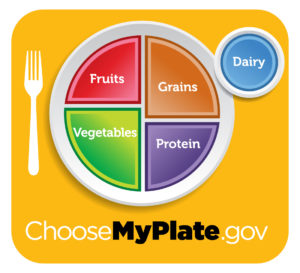A part of nutrition is knowing what and how much to put on your plate. A great tool for learning how to balance food groups is MyPlate. The main food groups are: protein, grains, fruits, and dairy* and vegetables. Each food group offers your body a different type of fuel and every body needs all these different types of fuel to work!
(*Some people are lactose intolerant, so non-dairy foods that are rich in calcium replace this group, like soymilk or almond milk. Some dark green vegetables like broccoli or kale can be a better source of calcium than milk!)
Portion control means getting the right amount of each food group, and it is something we all must learn. When choosing your portions, remember, “It’s all in the hands!” Here’s how to measure the right amount of food for your body using your hands. No matter if your hands are large or small, you’ll be able to find the right portion for your body.
Fruits and vegetables: your portion should fill your two hands cupped together.
Protein: your portion should be the size of the palm of your hand and the thickness of your pinky finger.
Grains and carbohydrates: your portion should be the size of your fist.
How to keep your portions in check:
- Instead of eating chips out of a bag, put a serving size in a bowl or a small plastic bag.
- Eat dinners from a plate – keeping in mind protein servings should be about the size of a card deck and your plate should be half full of fruits and veggies.
- Eating more calories when we’re really hungry is a common pitfall, so make a point to have regular meals throughout the day instead of one big one.
- Healthy snacks like peanut butter and apples or a handful of nuts and berries are great ways to carry you over until the next meal.
- Drinking 8 oz. of water 20 minutes before mealtime is a great way to eat fewer calories at your meals.
- Remember to eat slowly! It takes 15-20 minutes for your stomach to communicate to your brain that it is full, so wait before going for second helpings.


